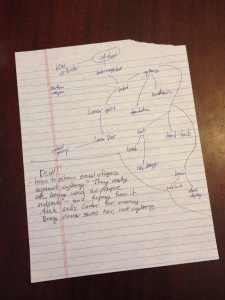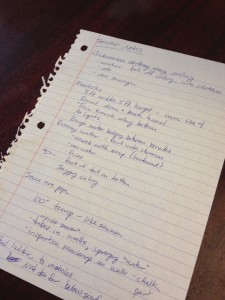BAM—You Have an Idea!
It’s usually something small. A character starts speaking to you in the back of your head, wanting to tell their story. Or you’re sitting on the bus one day, daydreaming, and a movie starts to play out in your head. Just a single scene first, but you want to know more. Or maybe it’s a concept. A What If. What if a comet hit the Earth right now? What if dinosaurs hadn’t gone extinct at all and still roamed around in our modern world? What if, what if, what if…?
I’ve heard of writers who sit down one day with the intention of coming up with a new story idea. There are plenty of brainstorming techniques for this. (James Scott Bell lists some great ones in his craft guide Plot & Structure.) But I, personally, have never done this. Every story idea I’ve ever had popped into my head when I wasn’t expecting it.
With Cinder, the idea of Cinderella turned into a cyborg came into my head as I was falling asleep one night and bam—head instantly full of possibilities.
With Heartless, it came in the middle of a conversation with my agent. We were talking about villains and fairy tale retellings and I off-handedly mentioned that I wanted to read a book that told the back story of the Queen of Hearts and—bam. Idea.
With the superhero series that I hope to start drafting this winter, I was on my way to a book signing and caught a construction sign out of the corner of my eye—one of those “Coming Soon to this Site: Another Strip Mall!” signs. But with my quick, disinterested glance, I thought the sign said something about superheroes. It didn’t, upon closer inspection, but . . . no matter. Bam—a light bulb went off.
So that’s where ideas come from. Anywhere, anytime, anyhow. I never know when they’ll hit, but I’m always ready to jot them down and explore them when they do.
Probably 80% of my ideas are written off as dumb, cliché, or overdone within the first day or two of having it. Those ideas get relegated to the back pages of my idea folder. Another 10% or 15% might hang on for months, even years, always one of those “I would like to write this someday” ideas that somehow always gets surpassed by something brighter and shinier and more of-the-moment. Maybe I’ll write them someday, maybe I won’t. I think of them as my back-up ideas—the ones I’ll write if the idea file otherwise runs dry.
And then there are the diamonds. The ideas that take hold and hang on. They keep coming back up in my imagination, again and again. Somewhere in the back of my thoughts, they start to percolate.
Eventually I know that this idea is going to be my next project. Then the fun begins.
Brainstorming
Once I have my heart set on turning an idea into a story, I start to dig a little deeper.
I ask a lot of questions: Who is the protagonist and what do they want? What other characters are needed for the story? Who is the love interest and how do they factor into the plot? What is the main conflict? What is the world like that the story takes place in?
There are no right or wrong answers. I write everything down, knowing that 75% of what I come up with at this point will probably be scrapped later when I come up with something better. I’m just exploring, poking at the idea to see what it does.
Those what if questions start to creep up, too. (The What If questions factor significantly into my whole process, so be prepared for a lot of them!)
– What if this cyborg Cinderella wasn’t a house servant, but a talented mechanic forced to earn money for her stepmother?
– What if her best friend wasn’t a mouse (Disney) or a bird (Grimm), but a robot?
– What if being cyborg was considered a bad thing, and the prince didn’t know what she was?
– What if there was an evil queen who wanted the prince for herself?
– What if, what if, what if . . .

Brainstorming notes for Cinder.
Research Part I: Inspirational / Market Research
I’ll have to keep looking things up until the day I turn a book over to my editor, but the bulk of my research happens right up front, in these first planning stages. While I’m asking all those What If questions in my head, I’m also actively gathering ideas from elsewhere in the world.
If the story is inspired by an existing story, I’ll go back to the source material. I’m reading it with a different eye than a reader wanting to be entertained. Now I’m on the hunt for inspiration.
With The Lunar Chronicles, I not only went back and read the Grimm versions of the stories, but I also read a few versions of the tales across times and cultures, along with modern adaptations. A lot of writers refuse to read anything similar to their WIP because they don’t want to be influenced by it. I get that, but I tend to take the opposite approach. I like to see what’s out there. What’s already been done, what might be veering toward the cliché, so I can see start thinking about what I want to do differently.
For example, as I was planning out Cinder, I went back and re-read (or re-watched? I can’t remember now) Ella Enchanted, one of my all-time favorite Cinderella retellings, and I discovered that some of the plot twists I had in mind were veering dangerously close to those in Ella Enchanted—and not just in a “they’re both Cinderella retellings” sort of way. So those plot twists got scrapped and I started looking for different directions I could go with it.
With Heartless, one of my first steps was to re-read Alice in Wonderland and Through the Looking Glass, looking for every tiny little detail about the “before” so that I could apply it to my Queen of Hearts-based prequel.
With my Superhero story, I’ve been watching all manner of superhero movies and marathoning the TV show Heroes. Always asking: What do I like about this? What don’t I like? What is it about superheroes that grabs me? What can I do differently? What would I have done if this was my story? What’s been done to death?
I take notes. Lots and lots and lots of notes. I make lists, too. Right now I have a list in my journal of “Superhero tropes I love” and “Superhero tropes I hate.” I’ll reference this list often as I start outlining to make sure I’m writing a story that I would also want to read.
Research Part II: Factual Research
And then there’s the type of research where I’m not looking so much for ideas, but authenticity. I start reading non-fiction books and articles and watching documentaries in an effort to populate my story with as many real-world details as possible.
For The Lunar Chronicles, I read many issues of Scientific American magazine to start building a foundation for the technological advancement in my futuristic world (which led to a lot of ideas about Cinder’s cybernetic parts!). I also read a book on the bubonic plague to inspire letumosis, and pored over China tourism guides, and walked the streets of Paris via Google Maps Streetview, and on and on.
For Heartless, I began with researching the Victorian era—from fashions to social etiquette to common foods—along with some of the historical people and events that supposedly inspired Lewis Carroll’s story.
My goal during this phase is to gather ideas (see a theme? More ideas and more ideas and more ideas . . .) until they start coming together to form a story. Often, this early research will lead to fascinating discoveries that will influence the entire plot.
For example, many of the hardships that Cress faces were directly inspired by the initial research I did on the Sahara Desert and survival tactics. Before that, all I’d known was that part of the book would take place in the desert, but it wasn’t until I started researching that part of the world that I could begin to fill in this gaping hole in the plot.

Some early research notes for Scarlet.
The Idea File
Though I do my most of my brainstorming on paper, during this stage I’m frequently updating my idea file. (For me, this is a basic word document.) I start to organize my ideas into things like “Character Concepts” and “Worldbuilding Details” and “Potential Scenes?”
The file starts to grow, and the pieces slowly start to come together and overlap, and then—hooray! I can see a vague story emerging from this overload of ideas.
Then it’s time to start outlining.
Stay tuned to learn more about my outlining techniques next week!